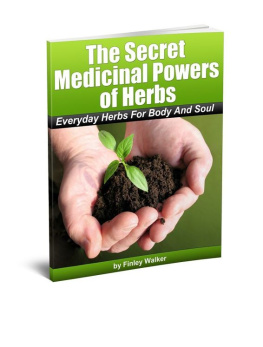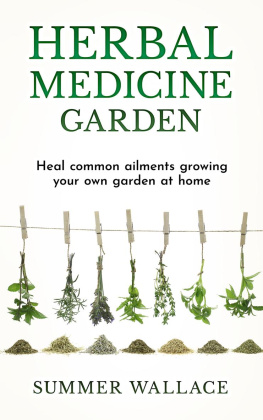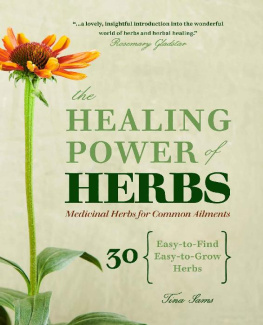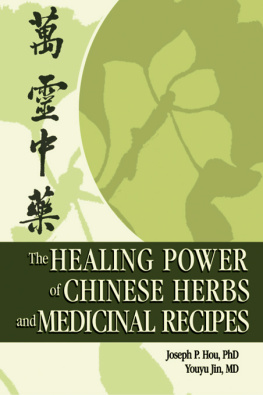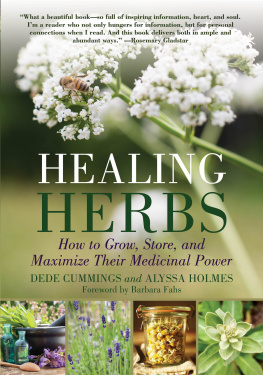Walker - The Secret Medicinal Powers Of Herbs
Here you can read online Walker - The Secret Medicinal Powers Of Herbs full text of the book (entire story) in english for free. Download pdf and epub, get meaning, cover and reviews about this ebook. year: 2012, genre: Home and family. Description of the work, (preface) as well as reviews are available. Best literature library LitArk.com created for fans of good reading and offers a wide selection of genres:
Romance novel
Science fiction
Adventure
Detective
Science
History
Home and family
Prose
Art
Politics
Computer
Non-fiction
Religion
Business
Children
Humor
Choose a favorite category and find really read worthwhile books. Enjoy immersion in the world of imagination, feel the emotions of the characters or learn something new for yourself, make an fascinating discovery.
- Book:The Secret Medicinal Powers Of Herbs
- Author:
- Genre:
- Year:2012
- Rating:5 / 5
- Favourites:Add to favourites
- Your mark:
- 100
- 1
- 2
- 3
- 4
- 5
The Secret Medicinal Powers Of Herbs: summary, description and annotation
We offer to read an annotation, description, summary or preface (depends on what the author of the book "The Secret Medicinal Powers Of Herbs" wrote himself). If you haven't found the necessary information about the book — write in the comments, we will try to find it.
The Secret Medicinal Powers Of Herbs — read online for free the complete book (whole text) full work
Below is the text of the book, divided by pages. System saving the place of the last page read, allows you to conveniently read the book "The Secret Medicinal Powers Of Herbs" online for free, without having to search again every time where you left off. Put a bookmark, and you can go to the page where you finished reading at any time.
Font size:
Interval:
Bookmark:
THE MEDICINAL POWER OF HERBS
TABLE OF CONTENTS
~~~~~~~
In the days before there were drugs and medicine, plants and herbs were mankind's only resource in fighting sickness, disease, and injury. The use of herbs and other plants for their medicinal power dates back to before recorded history. Evidence of herbs was found at the burial site of a Stone Age man. References to the practice of herbal medicine can be found in ancient texts from China, the Middle East, Babylon, and the Bible, to name a few. King Hammurabi prescribed mint for a stomach upset. Doctors today follow the same advice. In Ancient Greece and Rome, Hippocrates, considered the father of medicine and also the man for whom the Hippocratic oath is named, also advocated the use of certain herbs for wellbeing. He is reported to have said, "Let your food be your medicine and your medicine be your food." Today, even with the power of modern medicine and chemical drugs, herbal (or botanical) medicine is still very much in practice.
In the Middle Ages, women who practiced this herbal medicine did so with a generous mixture of spells and chants. They were known as "wise women" and were the forerunners for what people more recently called "witches". Fortunately, the practice of herbalism has lost the taboo stigma that it had during that era. In contrast, but just as importantly, monks of the church also studied the healing properties of herbs and practiced this kind of medicine in their monasteries.
Many believe that the cure for any disease, up to and including cancer and AIDS, can be found somewhere in the flora of the earth. Health benefits can be derived from the seeds, leaves, flowers, fruits, and roots of thousands of plants and herbs. They can be made into tinctures, extracts, capsules and tablets, teas, lozenges, and ointments, salves, and rubs. They are sold in drug stores and health food stores, and a growing number of people are choosing to grow the herbs and make their own treatments, medicines, and remedies. The herbal supplement industry is not regulated by any agency or organization, so care must be taken to check ingredients and dosage amounts.
In addition to what we know from scientific research and human trial and error, people have also learned about herbs by watching animal behavior. Some herbivores will choose a different plant to eat when they are sick that they would not normally eat. Nature tells us what we need to know if we only watch and listen!
Truthfully, modern medicine would not be where it is without the history and background of the study of herbs for healing purposes, so we should not view them as being mutually exclusive. Fortunately, the trend seems to be that more and more doctors understand the benefits of combining modern drugs with herbal supplements. In fact, many medicines that we consider to be "modern" actually come from plants. Opium comes from the poppy flower, aspirin is made from salicylic acid found in willow bark, digitalis (a heart medication) is derived from foxglove, and quinine (the treatment for malaria) is found in the bark of the cinchona tree.
Scientists have identified about 12,000 species of plants that have some medicinal, or healing, qualities. They also estimate that this number is only 10% of the actual number of beneficial plants. Although the practice has been around since before recorded history, it seems that we have only just begun to tap into the wealth of our natural resources.
~~~~~~~
GARLIC

Garlic ( Allium sativum ) belongs to the onion genus , Allium . It is native to central Asia, and has long been a staple in the Mediterranean region, as well as a frequent seasoning in Asia, Africa, and Europe. It grows up to 0.6 m (2ft) in height.
For years, garlic has been used both as food and medicine. In early 18th-century France, gravediggers drank crushed garlic in wine, believing it would protect them from the plague that killed many people in Europe. During World Wars I and II, soldiers were given garlic to prevent gangrene. Today, garlic is used to help prevent heart disease, including atherosclerosis.
Garlic is also used to prevent certain types of cancer, including stomach and colon cancers. In fact, in countries where garlic is consumed in higher amounts because it is so common in the traditional cuisine, the people have been found to have a lower prevalence of cancer. Studies also revealed that garlic supplementation reduced accumulation of cholesterol on the vascular walls of animals -- significantly reducing aortic plaque deposits.
Garlic has been found to reduce platelet aggregation and hyperlipidemia . It is also used to treat common colds and cough.
Garlic is also alleged to help regulate blood sugar levels. Regular and prolonged use of therapeutic amounts of aged garlic extract lowers blood homocysteine levels and has been shown to prevent some complications of diabetes mellitus .
Because of its bacteriostatic and bactericidal properties, garlic cloves are used in treating a wide range of bacterial infections. Garlic has also been found to enhance thiamin absorption and therefore reduces the likelihood of developing beriberi . Garlic is also rich in Vitamin C, thus preventing scurvy. It also contains antioxidants, which help neutralize free-radical buildup in the body.
ALFALFA
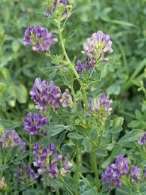
Alfalfa ( Medicago sativa ) is a perennial flowering plant that belongs in the pea family Fabaceae . Alfalfa originally grew in the Mediterranean and Middle East but has now spread to most of Europe and the Americas. In fact, it is the most cultivated forage legume in the world.
Alfalfa superficially resembles clover , with clusters of small purple flowers, followed by fruits spiraled in two to three turns, containing 10-20 seeds. It normally lives four to eight years, but can live more than 20 years, depending on the variety and climate . It can grow up to a height of one meter (3 ft.), and has a deep root system, sometimes stretching more than 15 meters (49 ft.) making it very resilient, especially to droughts.
For years, alfalfa has been used as an herbal medicine . It is a rich source of protein , calcium , and vitamins B, C , D , E , and K . The sun-dried hay of alfalfa has been found to contain 48 ng/g (1920 IU/kg) of vitamin D2 and 0.63 ng/g (25 IU/kg) of vitamin D3.
Alfalfa has been used to treat morning sickness, nausea, kidney stones, kidney pain and urinary discomfort. It is a powerful diuretic and has stimulant effects, helping to energize after a bout with illness. It is a liver and bowel cleanser and long-term use can help reduce cholesterol by preventing cholesterol absorption in the gut.
SAGE
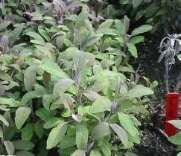
Sage ( Salvia officinalis ) is a perennial evergreen shrub , with woody stems, grayish leaves, and blue to purplish flowers. It is a member of the family Lamiaceae and is native to the Mediterranean region, though it has naturalized in many places throughout the world.
Salvia and "sage" are derived from the Latin word salvere (to save), which refers to the healing properties long attributed to the various Salvia species. In a double blind, randomized and placebo-controlled trial, sage was found to be effective in the management of mild to moderate Alzheimer's disease. Sage also aids digestion, relieves cramps, reduces diarrhea, dries up phlegm, fights colds, and reduces inflammation and swelling. Its antiseptic qualities make it an effective gargle for the mouth where it can heal sore throats and ulcers. The leaves applied to an aching tooth will often relieve the pain. Sage is also used orally in the treatment of excessive lactation, night sweats, excessive salivation (as in Parkinson's disease), profuse perspiration (as in TB), anxiety, depression, female sterility, and menopausal problems. Externally, it is used to treat insect bites, skin, throat, mouth and gum infections, and vaginal discharge. The leaves are best harvested before the plant comes into flower and should be dried for later use.
Next pageFont size:
Interval:
Bookmark:
Similar books «The Secret Medicinal Powers Of Herbs»
Look at similar books to The Secret Medicinal Powers Of Herbs. We have selected literature similar in name and meaning in the hope of providing readers with more options to find new, interesting, not yet read works.
Discussion, reviews of the book The Secret Medicinal Powers Of Herbs and just readers' own opinions. Leave your comments, write what you think about the work, its meaning or the main characters. Specify what exactly you liked and what you didn't like, and why you think so.

